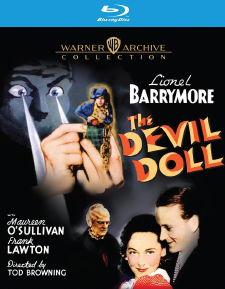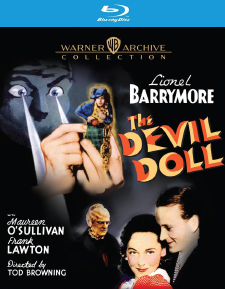Devil Doll, The (1936) (Blu-ray Review)

Director
Tod BrowningRelease Date(s)
1936 (October 24, 2023)Studio(s)
Metro-Goldwyn-Mayer (Warner Archive Collection)- Film/Program Grade: A
- Video Grade: A
- Audio Grade: A
- Extras Grade: B
Review
The Devil Doll stars character actor Lionel Barrymore as a Devil’s Island escapee determined to take revenge on the three men who framed him for embezzlement and murder. Directed by Tod Browning (Dracula, Freaks), the film combines science fiction and horror and features early special effects.
Paul Lavond (Barrymore) and fellow convict, aged Professor Marcel (Henry B. Walthall, The Road to Mandalay), help each other to escape the formidable prison. Marcel, who had been experimenting with miniaturization before his arrest, leads Lavond to a remote house where Marcel’s wife, Malita (Rafaela Ottiano, Anthony Adverse), has been carrying on his experiments. Marcel shows Lavond a group of toys and demonstrates that they are actual animals that he has miniaturized, deactivated, and can bring to life through telepathy. His goal is to end hunger and starvation by shrinking humans so the entire world’s increasing population can be fed. Marcel and Malita are ready to experiment on a human being—their housekeeper, Lachna (Grace Ford, Thrill of a Romance).
When the experiment proves successful, Lavond sees in the doll-sized, entirely controllable woman a means to exact his revenge. To escape detection by the police, he poses as an elderly female storekeeper, calls himself Madame Mandilip, and begins using miniaturized humans to finally avenge himself for the seventeen years he was wrongfully imprisoned. By hiding in plain sight, he can easily gain access to the men who stole those years from him. Those stolen years have also stolen his family, and Lavond hopes to reconcile with his now-adult daughter, Lorraine (Maureen O’Sullivan, Tarzan, the Ape Man) before he’s caught.
Of the many impressive special effects in The Devil Doll, the one that struck me most was the large-scale furniture built to make the actors look one-sixth their normal size. In one extended, suspenseful sequence, a tiny assassin aiding in a robbery and murder adroitly negotiates what to her are mountainous obstacles—a slipper, a footstool, a bench, and drawer handles—to accomplish her task. Matting is used for scenes that require the small people to be seen together with normal-sized people. There’s a visible outline around the matted dolls.
Barrymore’s portrayal of Lavond disguised as Madame Mandilip is reminiscent of Lon Chaney’s female impersonation in both versions of The Unholy Three. With a high-pitched voice, stooped posture, and granny clothing, Barrymore transforms himself into the purveyor of the deadly toys. Barrymore’s performance as Lavond inspires sympathy for the betrayed man so that when he goes after the bankers who’ve wronged him, we root for him. His novel method of seeking revenge might be a bit convoluted, but it’s fascinating.
Rafaela Ottiano as Malita is reminiscent of both Elsa Lanchester in Bride of Frankenstein with her shock of black hair shot through with a thick streak of white, and Dwight Frye in Dracula with her mad, bulging eyes. Ottiano’s Malita walks with a pronounced limp, adding yet another element of oddness to her performance. She might be the first female mad scientist of the screen, as Malita is clearly obsessed and easily drawn into Lavond’s scheme to use the dolls for a nefarious purpose. Ottiano may chew the scenery in more than a few scenes, but that also contributes to the character’s creepiness.
Browning crafted a unique picture and had the considerable resources of MGM to bring his vision to fruition. With the film’s many quiet sequences, he emphasizes visuals and tells key parts of the story through well-planned shots and reliance on pantomime. For a director whose career started during the silent period, this isn’t surprising. The scenes with dialogue also come off quite effectively, particularly a climactic scene in which Lavond finally sees Lorraine. Some scenes are simply charming, such as when a full-sized St. Bernard peers curiously at a bunch of miniature dogs running around on a table top. Though Browning’s Dracula and Freaks are more famous, The Devil Doll ranks right up there with them.
This was one of the first American films to incorporate a science fiction element into the plot, though it retains a strong basis in horror. It was a forerunner of other films about miniature people, such as Dr. Cyclops and The Incredible Shrinking Man.
The Devil Doll was shot by director of photography Leonard Smith on 35 mm black & white film with spherical lenses and presented in the aspect ratio of 1.37:1. A new 4K scan of preservation elements provides a beautiful, pristine image with excellent grain replicating actual film. This represents another feather in Warner Archive’s cap for restoring movie classics. Blacks are deep and velvety and the grayscale outstanding. The optical shots lack the perfect integration of CGI with live action but nonetheless hold up well and are entertaining. Details such as the miniature dogs, equipment in Marcel and Malita’s lab, wrinkles on Madame Mandilip’s face, thick foliage, and close-ups of expensive jewelry are well delineated.
The soundtrack is English 2.0 Mono DTS-HD Master Audio. English subtitles are an available option. Sound overall is perfectly clear with no pops or other age-related imperfections. Dialogue is clear and distinct. Barrymore as Madame Mandilip speaks with the high-pitched voice of an elderly woman. Rafaela Ottiano speaks with a maniacal intonation. Franz Waxman’s score is particularly effective in adding just the right atmosphere to the unusual tale. Sound effects include flasks bubbling in the lab, ambient street traffic, a clock chiming, and Malita’s full-sized dogs barking.
Bonus materials on the Blu-ray release from the Warner Archive Collection include the following:
- Audio Commentary by Dr. Steve Haberman and Constantine Nasr
- Milk and Money (8:09)
- The Phantom Ship (7:36)
- Trailer (1:54)
Audio Commentary – The commentators note that The Devil Doll has gotten the “short shrift’ in terms of recognition, referring to it as the most accessible of Tod Browning’s talkies and a film that provides an “emotional ride.” Based on the novel Burn, Witch, Burn!, the original plot of the film was about witchcraft and the working title was The Witch of Timbuktu. Special effects in the 1930s had advanced significantly. Arnold Gillespie headed the special effects department at MGM, which purchased $75,000 in equipment to make the effects look as believable as possible. The Devil Doll was a typical studio production that went through several rewrites, and various versions of the script are discussed. The film had several writers, including Garrett Ford, Guy Endore, and Erich Von Stroheim, whose 211-page treatment was far too long. The final shooting script was representative of Browning’s style. Lionel Barrymore was not well at the time the film was made and used a wheelchair, but was up to the job when “action” was called. Rafaela Ottiano, who plays Malita, was a member of the Grand Guignol Theater of Paris. The film is suspenseful, imaginative, and creepy, with an almost spiritual ending that’s emotional rather than shocking. The Devil Doll emphasizes vengeance but Lavond finds vengeance empty. By giving his daughter peace, he makes a selfless gesture. The commentators observe that “Tod Browning was one of only a few complete directors.”
Milk and Money – In this black & white Looney Tunes cartoon from 1936, with animation by Chuck Jones and Virgil Ross, Porky Pig applies for a job as a milkman with a strict condition not to break a single bottle. He’s doing well until Hank Horsefly follows him into town. He stings Porky’s horse, Dobbin, who crashes and causes all the milk bottles to smash. They come upon a horse race and accidentally enter. Dobbin is taking his time until he gets stung again. Porky wins the $10,000 race and drives home in a limousine.
The Phantom Ship – From 1936, this black & white Looney Tunes cartoon was animated by Paul Smith and Don Williams. Uncle Beans and the kids are off to visit a haunted ship trapped in the ice, hoping to find a pirate treasure. They encounter ghosts and goblins but eventually find what they’ve been looking for. When Beans tries to warm up by throwing some chairs in a stove and lighting it, he thaws out a pair of pirates that chase the trio around. The treasure seekers are ultimately forced back into their plane and they decide to fly away.
Tod Browning was known for having a great eye for weirdness and the macabre. In The Devil Doll, his next-to-last film, he balances a chilling quality with pathos, elevating a tale of vengeance to an excursion into mad science, horror, and obsession.
- Dennis Seuling

